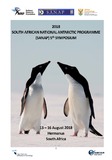
Antarctic Legacy Archive
Characterisation of hypolith communities in Dronning Maud Land, Antarctica
- ALSA Home
- →
- Documents
- →
- Research Events
- →
- View Item
JavaScript is disabled for your browser. Some features of this site may not work without it.
| dc.contributor.author | Mikhari, R.L. | |
| dc.coverage.spatial | Antarctica | |
| dc.coverage.spatial | Dronning Maud Land | |
| dc.coverage.spatial | Eastern Antarctica | |
| dc.date.accessioned | 2021-03-05T15:52:50Z | |
| dc.date.available | 2021-03-05T15:52:50Z | |
| dc.date.created | 18-Aug | |
| dc.date.issued | 18-Aug | |
| dc.identifier.uri | http://hdl.handle.net/123456789/28438 | |
| dc.description.abstract | Antarctica is an extremely cold, dry and windy environment covered mostly in ice and permafrost soil. Despite the harsh environment, Antarctica harbors diverse and thriving microbial communities in a variety of micro-niches, one of which is hypoliths. Hypoliths are a heterogenous community of microorganisms that develop at the ventral side of mostly translucent rocks in extremely hot or cold desert environments. The Dry Valley Deserts in western Antarctica, are known to harbor hypolith communities. However, no information thus far has been published on hypoliths from the Dronning Maud Land (eastern Antarctica.. In this study, high-throughput targeted amplicon sequencing of the 16S rRNA genes was used to characterize the microbial diversity within hypolith communities in the Dronning Maud Land. Hypolith communities were found to be dominated by Proteobacteria and Bacteroidetes, followed by Actinobacteria, and were also found to be distinctly different from those isolated from Dry Valley Desert hypoliths. Abiotic factors, such as location, slope aspect, elevation and type of rock under which the hypolith was found, were taken into consideration during this analysis. None of these factors, however, appeared to play a role in the diversity and distribution profiles of the hypolithic microbial communities in this study. Nevertheless, during statistical analysis, microbial communities were observed to group into four distinct clusters and it is proposed that these groupings are representative of developmental succession. In conjunction with this study, the potential for involvement in nitrogen cycling within these communities was assessed, since Antarctica is characterized by a low nitrogen input. - Abstract as displayed in the - Abstract booklet. The presentation on the day may differ from the - Abstract. | en_ZA |
| dc.description.sponsorship | Sponsored by the the Department of Science and Innovation(DSI) through National Research Foundation (NRF) - South Africa | en_ZA |
| dc.description.statementofresponsibility | Antarctic Legacy of South Africa | en_ZA |
| dc.format | en_ZA | |
| dc.language | English | en_ZA |
| dc.language.iso | en_ZA | en_ZA |
| dc.publisher | South African National Antarctic Programme (SANAP. | en_ZA |
| dc.relation | SANAP Symposium 2018 | en_ZA |
| dc.rights | Copyright | en_ZA |
| dc.rights | Copyright | en_ZA |
| dc.subject | Research | en_ZA |
| dc.subject | Science | en_ZA |
| dc.subject | Meetings | en_ZA |
| dc.subject | Symposium | en_ZA |
| dc.subject | SANAP Symposium 2018 | en_ZA |
| dc.subject | Living Systems | en_ZA |
| dc.subject | Terrestrial Science | en_ZA |
| dc.subject | Antarctica | en_ZA |
| dc.subject | Dronning Maud Land | en_ZA |
| dc.subject | Microbiology | en_ZA |
| dc.subject | Genetics | en_ZA |
| dc.subject | Sequencing | en_ZA |
| dc.subject | Microorganisms | en_ZA |
| dc.subject | Dry Valley Deserts | en_ZA |
| dc.subject | Microbial Communities | en_ZA |
| dc.subject | Bacteria | en_ZA |
| dc.subject | Nitrogen | en_ZA |
| dc.title | Characterisation of hypolith communities in Dronning Maud Land, Antarctica | en_ZA |
| dc.type | Abstracts | en_ZA |
| dc.rights.holder | Antarctic Legacy of South Africa | en_ZA |
| dc.rights.holder | Mikhari, R.L. | en_ZA |
| iso19115.mdconstraints.uselimitation | This item and the content of this website are subject to copyright protection. Reproduction of the content, or any part of it, other than for research, academic or non-commercial use is prohibited without prior consent from the copyright holder. | en_ZA |
| iso19115.mddistributor.distributorcontact | South African National Antarctic Programme -SANAP. | en_ZA |
| iso19115.mdformat.name | en_ZA | |
| iso19115.mdidentification.deliverypoint | Antarctic Legacy of South Africa, Faculty of Science, Private Bag X1, Matieland. Stellenbosch. South Africa. | en_ZA |
| iso19115.mdidentification.electronicmailaddress | antarcticlegacy@sun.ac.za | en_ZA |
| iso19115.mdidentification.organizationname | Rhodes University | en_ZA |
Files in this item
This item appears in the following Collection(s)
-
Research Events [502]
Material directly related to official scientific and research events
